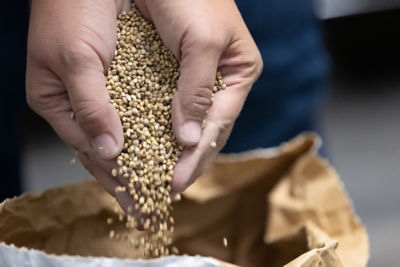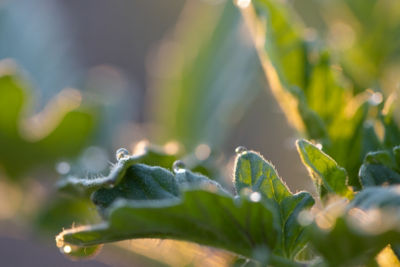Click here to download a PDF version of this spotlight.
» Biological agents can contribute to the effectiveness of integrated pest management systems for vegetable crop production.
» Beneficial arthropods, bacteria, fungi, and nematodes have been used successfully to help manage vegetable disease and pest
problems.
» Commercial biocontrol products are available for use on vegetable crops.
Integrated pest management (IPM) is a system that provides “a sustainable approach to managing pests by combining biological, cultural, physical, and chemical tools in a way that minimizes economic, health, and environmental risks.”1 IPM systems are designed to minimize unacceptable levels of pest damage while reducing risks to natural resources and the environment and suppressing the development of pests and pathogens with resistance to pesticides and other management practices.1 With increasing scrutiny on the use of chemical pest control products, biological pest control products are receiving more attention than ever and have become an important option for use in commercial vegetable production systems. Biological products use various modes of action to help manage plant diseases and pests. Some products act directly against pathogens and pests or their activities. Other products act indirectly by stimulating the plant’s own defense systems.
BIOCONTROL
Biological control (biocontrol) is the use of natural enemies or agents to help manage diseases and pests. In classic biocontrol systems, foreign agents (natural enemies) are introduced to help manage exotic (introduced) diseases and pests. However, with the potential adverse, non-target effects of introducing a foreign agent, these systems usually require extensive testing before they are approved for use.2
Augmentative biocontrol, on the other hand, uses agents that occur naturally in an area and works by increasing their numbers through the release of mass-produced agents. The releases can be inoculative, intended to introduce and establish a population to provide long-term suppression, or inundative, releasing large numbers to quickly overwhelm pests or pathogens for short-term suppression.2 Augmentative biocontrol usually works best in contained environments— such as greenhouses and high tunnels—or in small field areas.
A third method is conservation biocontrol, which uses habitat manipulation and changes in production practices to increase the populations and effectiveness of naturally present agents. This can include increasing plant diversity near the production area to provide shelter, habitats, food sources, and overwintering sites for the biocontrol agents.2
DIRECT BIOCONTROL
Biocontrol agents for arthropod pests include predators, parasites, and parasitoids. Predatory mites, such as species of Amblydromalus, Amblyseius, and Neoseiulus can be used to help manage thrips, whiteflies, spider mites, and fungus gnats. Lacewings, such as Chrysoperla, Micromus, and Sympherobius species, can help manage aphids, whiteflies, and mealybugs. Parasitic wasps, such as species of Aphidius and Trichogramma, are used against many kinds of insects, including aphids, leafminers, whiteflies, beetles, and caterpillar species. Entomopathogenic nematodes, fungi, and bacteria can be used to help manage a wide array of arthropod pests including aphids, whiteflies, leafhoppers, beetles, thrips, grubs, weevils, and caterpillar species.2 Fungi, such as Beauveria bassiana and Isaria fumosoroseus, can help suppress a number of insect pests. Bacteria—including species of Burkholdaria, Chromobacterium, and Bacillus—are commercially available as insect biocontrol products. Bacillus thuringiensis is one of the most successful and widely used insect biocontrol agents. Certain strains of this bacterium produce proteins that are toxic to insects when certain insects when ingested.2
Biocontrol agents for plant pathogens (bacteria, fungi, nematodes, and viruses) work using several different mechanisms. Some of these agents suppress pathogens by competing for nutrients, releasing antibiotic compounds, occupying infection sites, or directly parasitizing the pathogens.3 The QST 713 strain of the bacterium Bacillus subtilis produces several antimicrobial substances that help to inhibit spore germination and the growth of fungal pathogens, which may result in direct foliar disease control. This agent is commercially available as Serenade® ASO Biological Fungicide, Serenade® Opti Fungicide, and MinuetTM Fungicide.4,5 The bacterium Agrobacterium radiobacter is a close relative of the plant pathogen Agrobacterium tumefaciens, the causal agent of crown gall. A. radiobacter strain K84 can occupy infection sites and produce a toxin that can help suppress the development of crown gall on plant roots.2 This biocontrol bacterium has been marketed as Galltrol-A®. Species of the fungal genus Trichoderma have been used to help control soilborne plant diseases through competition for nutrients and parasitism of pathogens, and several commercial formulations are available, including RootShield® Plus+ WP biological fungicide.
Another example of a direct biocontrol agent is the fungus Coniothyrium minitans strain CON/M/91-08, which has been developed as the commercial product Contans® WG white mold fungicide to help suppress the pathogens Sclerotinia sclerotiorum and Sclerotinia minor. This biocontrol agent works by parasitizing sclerotia (the overwintering stage of these pathogens) in the soil, gradually reducing the soil population of the pathogen.
INDIRECT BIOCONTROL
Disease suppression can also result from the indirect effects of some bacterial and fungal biocontrol agents or through the application of chemicals that help activate the plant’s own defense mechanisms. Plants have inducible mechanisms of resistance that can be triggered by factors including infection by pathogens, the presence of non-pathogenic microorganisms, and the application of chemicals such as salicylic acid. Inducing resistance in one part of the plant can result in resistance developing systemically in other parts of the plant, a phenomenon known as systemic acquired resistance (SAR).4,6 The SAR reaction is expressed in the vicinity of infection as well as in more distant parts of the plant.7 The resulting resistance can be effective against many kinds of pathogens including bacteria, fungi, nematodes, and viruses, and the resistance can remain effective for several weeks.7,8
SAR responses can be induced by the application of salicylic acid and similar compounds.9 2,6-dichloro-isonicotinic acid (INA) and benzo (1,2,3) thiadiazole-7-carbothioic acid-Smethyl ester (BTH) are two of the best-studied SAR-inducing chemicals. BTH can help protect plants against some bacterial and biotrophic fungal pathogens (obligate parasites), such as powdery mildew and rust fungi. It is not as effective against diseases, such as anthracnose, caused by necrotrophic pathogens.9
Induced systemic resistance (ISR) is a phenomenon that is similar to but distinct from SAR. The presence of microorganisms, including PGPR organisms, can induce ISR in plants. Several strains of bacteria, including species of Pseudomonas, Bacillus, and Streptomyces, have been shown to elicit ISR responses in plants, as have some kinds of fungi. Unlike SAR reactions, ISR reactions do not depend on salicylic acid to trigger the defense response. Other plant chemicals, including jasmonate and ethylene, are involved in the ISRassociated defense responses.4,9 ISR elicitors activate or pre-activate plant defense mechanisms that can then be more rapidly triggered to help protect the plant against infection.
The bacterium Bacillus amyloliquefaciens subspecies plantarum (BexfondTM Biological Fungicide) and the bacterium Streptomyces lydicus WYEC 108 (Actinovate® SP Biological Fungicide) have also been developed as commercial ISR inducing products for agricultural use and can be applied as a soil drench, through chemigation, and as foliar sprays as indicated on the product labels.
INTEGRATION WITH OTHER METHODS
In IPM systems, it is important to correctly identify the pest/ pathogen species present so that the most appropriate management methods can be used in a coordinated manner.2 Regular scouting and monitoring for pests, pathogens, and symptoms should be used to allow management strategies to be initiated before the problem gets too severe. This is especially true when using biological agents, which are often more effective against small populations.2,10
Using biological management methods may require some adjustments to the use of other management practices, such as pesticides. Pesticide applications may be needed to help biocontrol agents “catch up” with a pest population or level of disease development.2 Selecting pesticide products and carefully planning the timing of applications can help prevent negative impacts on the biocontrol agents and natural enemies, allowing them to contribute to the management effort. Cultural practices—such as selective weed management to allow favorable habitats to develop and the use of disease and pest-resistant/tolerant varieties—can also help the biological management components be more effective.3 The efficacy of biocontrol agents can also vary with the production systems, suopen field vs. protected culture. Selecting the most appropriate combination of methods and control agents will help increase the effectiveness of the total IPM effort.
SOURCES
1U.S. Department of Agriculture. Integrated pest management. https://www.usda.gov/oce/pest/integrated-pest-management.
2Jeffers, A. and Chong, J. 2021. Biological control strategies in integrated pest management (IPM) programs. Land-Grant Press by Clemson Extension. LGP 1111 https://lgpress.clemson.edu/publication/biological-control-strategies-in-integrated-pestmanagement-ipm-programs/.
3Souza, R., Ambrosini, A., and Passaglia, L. 2015. Plant growth-promoting bacteria as inoculants in agricultural soils. Genetics and molecular biology, 38(4), 401–419. https://doi.org/10.1590/S1415-475738420150053.
4Schumann, G. and D’Arcy, C. 2010. Essential plant pathology, Second edition. The American Phytopathological Society. St. Paul.
5Vallad, G. and Goodman, R. 2004. Systemic acquired resistance and induced systemic resistance in conventional agriculture. Crop Sci. 44:1920–1934.
6Agrios, G. 2005. Plant pathology, 5th edition. Elsevier - Academic Press.
7Sticher, L., B. Mauch-Mani, and J.-P. Me´ traux. 1997. Systemic acquired resistance. Annu. Rev. Phytopathol. 35:235–270.
8Gozzo, F. and Faoro, F. 2013. Systemic acquired resistance (50 years after discovery):moving from the lab to the field. Journal of Agricultural and Food Chemistry. 61 (51):12473–12491.
9Manker, D. 2004. Natural products as green pesticides. In Clark and Ohkawa; New Discoveries in Agrochemicals. ACS Symposium Series; American Chemical Society:Washington, DC, 2004.
10Chong, J. and Gill, G. 2021. Biological control options in vegetable production. https://www.eorganic.info/sites/eorganic.info/files/u461/BiocontrolGunn_JC_0.pdf.
Websites verified 1/6/2024
ADDITIONAL INFORMATION
For additional agronomic information, please contact your local seed representative. Performance may vary, from location to location and from year to year, as local growing, soil and environmental conditions may vary. Growers should evaluate data from multiple locations and years whenever possible and should consider the impacts of these conditions on their growing environment. The recommendations in this article are based upon information obtained from the cited sources and should be used as a quick reference for information about vegetable production. The content of this article should not be substituted for the professional opinion of a producer, grower, agronomist, pathologist and similar professional dealing with vegetable crops.
BAYER GROUP DOES NOT WARRANT THE ACCURACY OF ANY INFORMATION OR TECHNICAL ADVICE PROVIDED HEREIN AND DISCLAIMS ALL LIABILITY FOR ANY CLAIM INVOLVING SUCH INFORMATION OR ADVICE.
5014_483661 Published 01/13/2025




